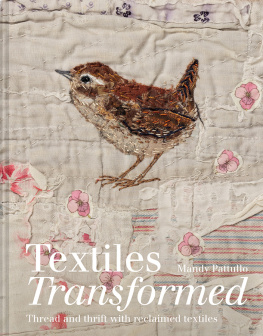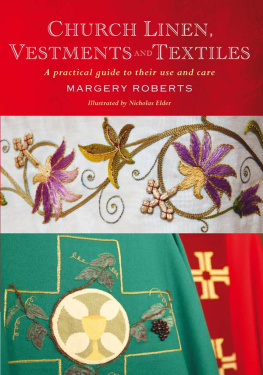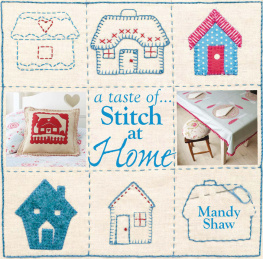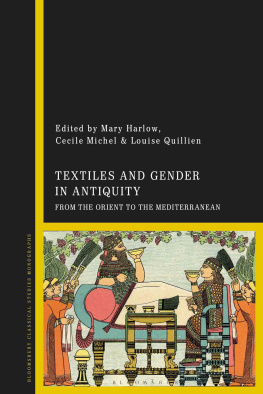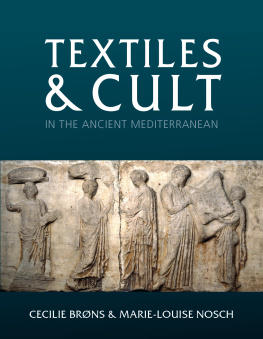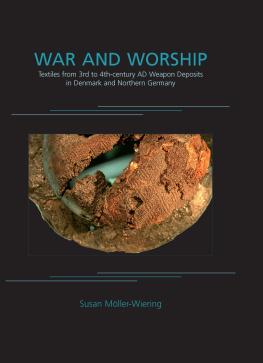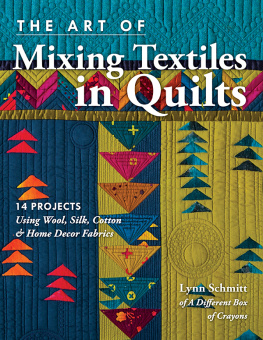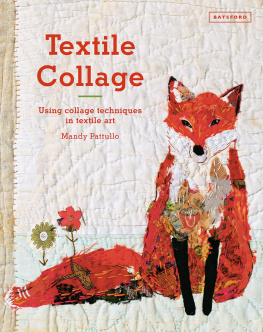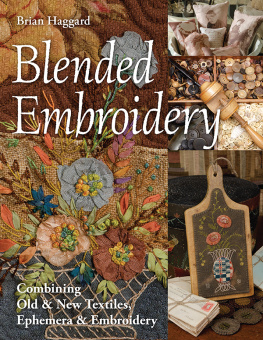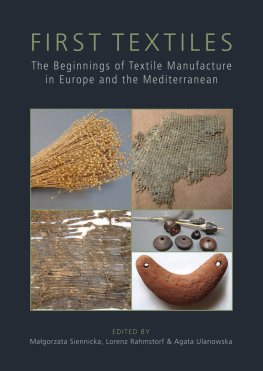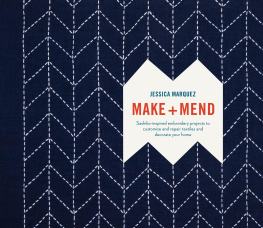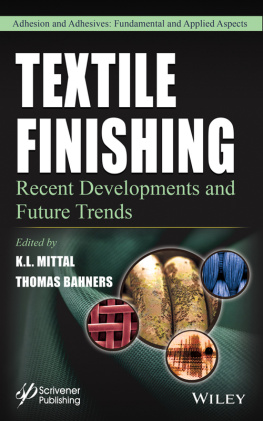Contents
Guide
Textiles
Transformed

Textiles
Transformed
Thread and Thrift with
Reclaimed Textiles
Mandy Pattullo

Contents
Introduction
I rent a studio in a converted manse (clergymans house) in a pretty village in Northumberland in the north of England. Having worked hard all my life as a teacher, surface pattern designer and mother, I feel I have earned this room of my own where I can surround myself with beautiful fabrics and threads, plug in my headphones and lose myself in constructing textile collages and hand stitching. I seem to have been collaging my whole life, whether that be in the scrapbooks I have been making since I was a young child, creating mood boards for clients and students, curating the mantlepiece in my home or sorting my fabrics into bundles of interesting combinations.

Work in progress at my studio in Northumberland.
I work by hand because I choose to, and I have a deep need to employ my hands to some practical purpose. I garden, cook, sew and play the piano, but making a stitch and patching together pieces of cloth is absolutely integral to who I am. I was probably sewing when I met my husband more than forty years ago and my children would think it odd not to see me combining stitching with having a conversation, watching the TV or relaxing on holiday. I love the whole process: gathering and searching out lovely things, creating colour stories and moods, deciding on the composition and surface decoration and then creating something new. It is not just the slowness of stitching by hand and being in the zone when doing it that I love, but also about the power of transforming something by making my own mark on it.
I use a carefully selected collection of old and worn textiles that have been gifted to me or have been sourced at antique textile fairs and flea markets. These are beautiful textiles that hold within them their own story and you might ask why I feel the need to decorate them, cut them up and reassemble them into new pieces. I often wonder why myself, but I think it is about changing the textile surface, taking ownership of it and then re-presenting it so it transforms from something someone once made or wore into a new piece of my own. If I just kept the textiles folded and stored I would probably not look at them very often, but by interacting with them over a period of time I build up a relationship with the cloth and the previous maker as I unpick their stitches, deconstruct their garment or embroidery and use it for myself. The resolved textile piece is then shared and talked about with those who come into my studio, shared to a wider audience across the world through social media and then might act as an inspirational sample to those I teach. Is this not a better thing than the original being seen and owned by only me?
I hesitate to use the words upcycling or recycling in relation to what I do as I do not really make anything that is useful or serves a purpose. I prefer to apply the word reworking as I am using what I have found, items that have had a previous life and, in the end, what I make doesnt have to be useful if it feeds my soul and is a sustainable craft technique. In this book I hope to convey some of the excitement I feel at the transformative process of changing a textile piece, and encourage you to do the same. You will not be able to re-create what I do as everything I source and make is unique, but I hope I can give you the confidence to have a go and inspire you to rework things you own, to find in them the tender details and add a few of your own.

The Basics
Fabrics
You will see that I mostly work with beautiful old fabrics and pieces of quilt. Some of the fabrics are inherited or gifted, many are charity-shop garments or family clothing, such as my husbands worn-out shirts, that have been taken apart. I try to work using only what I already have. Look in charity shops for blankets, domestic embroidered items, headscarves and quality vintage garments. For truly vintage and antique textiles, including quilts, I make special trips to vintage textile fairs, auctions, flea markets and brocantes. I do not expect to get something for nothing and am always willing to pay a reasonable amount for a quilt or exquisite piece of embroidery that I know both my students and I can make the most of. There are lots of people selling vintage textiles through Ebay, Etsy and Instagram now, so if you are committed to having a go at making work like that illustrated in this book, search it out and start to assemble a collection. You can also age new fabric if you knock back the colour by dipping it in a tea solution or overdyeing using natural dyes that are not damaging to the environment. You might like to mix in some more contemporary fabrics such as patchwork cottons; companies like French General () have quilting fabrics inspired by beautiful antique French designs that I find mix well with my genuinely antique pieces.

The sort of fabrics I collect include recycled clothing scraps, wool and quilt pieces.
Textile Collage
Nearly everything I make is patched or collaged together onto a foundation fabric. I wrote about this extensively in Textile Collage (Batsford, 2016) but I would encourage you to have a colour story for all projects; have a piece of fabric or embroidery to incorporate that really makes your heart sing, and work instinctively rather than over-planning. Let your fabrics tumble together they will find their partners more easily if they are not regimented into boxes containing all the same colour.

Foundations and Attaching
I do not like to embroider within a hoop so everything I work with has to have a foundation fabric firm enough that the stitching will not pull the fabric collage out of shape. I increasingly use a bonded curtain lining, which is fabric on one side with a wadding bonded on to it, and I place the collage materials on the fuzzy wadding side. I find as I stitch together and embroider on to this sort of backing it quilts it as the stitches sink into the two layers underneath. I also use wool felt, old blanket and pieces of thin quilt as foundations for patchworking on to. If you are working with a garment you do not need to consider a background, though if the fabric of the garment is thin or woollen you might need to stretch it into a frame while you work on it.
Everything I make is hand stitched and, unless I have chosen to turn the edges, everything is sewn on to the foundation or garment with either a stab stitch just within the edge of the cloth, or an overcast stitch over the edge of the cloth. You could also attach with buttonhole stitch, cross stitch or herringbone stitch. In the diagrams, the attaching stitches are very obvious, but in reality I use the same colour thread as the fabric to make the stitches as invisible as possible. If I have chosen to turn the edge of the fabric I am appliquing I use slipstitch in the traditional way.

